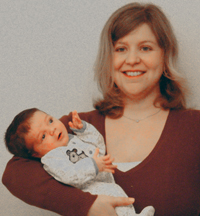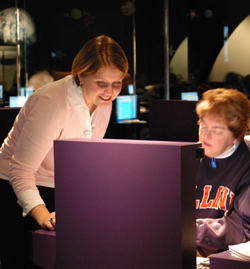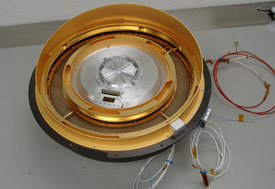Meet the IBEX Team: Lindsay Bartolone

Lindsay Bartolone has always been a dancer. In high school, she spent up to 20 hours a week in dance classes. As a college student, she joined a dance troupe, and then found a way to "dance to a different drummer" by shaping her own major to study both astrophysics and education.
Today, Lindsay has a job that exactly matches her varied academic interests. As a senior educator at the Adler Planetarium & Astronomy Museum in Chicago, she uses her astrophysics and education training to find the best ways to teach people about space science, including the IBEX mission. "Luckily, I've been able to create a perfect niche for myself. I managed to study astronomy education in school, and that's what I do as a job. I don't know how many people actually get the opportunity to shape their education and find a career that directly matches that," she said.

Lindsay works on the IBEX mission as the Education and Public Outreach Lead. "My job is to explain the excitement and purpose of the mission to various segments of the public," Lindsay said. She guides teams of Adler Planetarium educators, scientists and multimedia designers to create products that explain the IBEX mission. These products include a full-length planetarium show, as well as an IBEX web site, a
curriculum guide for middle school teachers, posters, bookmarks, and more. She conducts and supervises evaluations of the products to make sure that they meet the needs of the intended audiences.
As the IBEX E/PO lead, Lindsay also makes presentations about the E/PO program to NASA review committees and science teams. One of her biggest jobs includes working with project managers to make sure that the program is on time and within budget.
Science and space exploration have interested Lindsay since she was a child. "I was always a 'science kid'. I preferred science and math to spelling - I was a terrible speller, and I still am. A lot of the time people would tell me, as a little girl, 'Oh you like science? You should be a doctor,' but I never wanted to touch anything icky! Astronomy is one of the few sciences where you have to use scientific reasoning without having to touch the thing you're studying," she said.
She even wanted to be an astronaut in fourth grade, and wouldn't turn down a trip on the space shuttle if it were offered to her as an adult. "I would love to take a trip into space one day. There are opportunities coming up for educators to fly on an infrared observatory that is in an airplane (
SOFIA). I'd also love to take a ride in the
'vomit comet'!" she said.
In sixth grade, Lindsay transferred from a public school to a private girls' school. "Being in an all-girls school probably helped me have confidence in my science and math classes," Lindsay said. This confidence led her to enter Princeton University as an engineering major.
However, Lindsay soon discovered that she was more interested in astronomy than engineering. "After the first year I was supposed to pick what kind of engineer I wanted to be, and I decided what I really wanted to study was the stars. Even though I liked the way engineers worked in teams to solve problems, I decided to transfer to the Astrophysics Department," she said.
As one of three astrophysics students in her cohort, Lindsay found that her astrophysics classes were more difficult than her engineering ones. "I knew it was going to be more challenging, but I made the decision that it was okay if I didn't end up with perfect grades if I was able to take the subjects that I enjoyed," she said.
About that time, Lindsay discovered that she was also interested in education. "I realized that the fact that I liked to solve problems in a team was something that teachers did... I also took a class called Women in Science, and since I'd been wondering why I wasn't doing as well in my college classes as in high school, I found out that the teaching techniques used in college weren't as effective for all students. So, I started exploring teaching styles and techniques that were advantageous for all kinds of students," she said.
Although Princeton did not have an astronomy education program, Lindsay worked with the faculty in the Astrophysics Department and the Program in Teacher Preparation to fashion a major that allowed her to study both subjects. "I'd recommend creating your own major," she said. "Many colleges are open to it."
While a junior in college, Lindsay combined her astrophysics and education experience by working on an education research project for the Wilkinson Microwave Anisotropy Probe (WMAP) NASA mission. "It started with a simple web page for
teachers and ended up with a job that I've had for almost 10 years now. Most of what I do with the WMAP mission is try to work with other NASA missions that have a similar focus to help people understand the size and structure of the universe," she said.
After graduating from college in 1999, Lindsay accepted a summer job at the Hayden Planetarium at the American Museum of Natural History in New York. When an astronomy education job opened up at the Adler Planetarium, Lindsay jumped at the opportunity to take a full-time position in her field, and to move to Chicago, where her future husband was pursuing a PhD. She has found the experience incredibly rewarding. "Helping people to understand something is the best part of my job. When they feel like they've learned something about the universe, it's often very satisfying because I think some people feel that understanding science or astrophysics is beyond them. But really, anyone can understand it if it's presented in a way that connects with what they already know," she said.
Balancing her regular education duties with the responsibility of leading the outreach efforts for the IBEX mission is challenging, but a lot of fun. "I've enjoyed working with so many different kinds of people, and I really get the opportunity to work with engineers, children, and adults and that's really nice," Lindsay said.
Lindsay says that education specialists sometimes find it difficult to collaborate with scientists, but the IBEX mission has proven to be an excellent partnership. "I've had fantastic support from the IBEX science team!" Lindsay said.
She finds that many people who work on the IBEX mission come from a variety of backgrounds, and do not necessarily have experience in science. "There are so many different ways to be involved with a NASA mission. You don't have to be an engineer. Many of the people that I work with studied art in school and are now helping to communicate about the IBEX mission," she said.
She recommends that students who want to pursue a career in astronomy education should study a variety of subjects in college. "I think it's important to have a multi-disciplinary approach to your own education. Because people learn in so many different ways, you can use all different subject areas to explain science concepts. Take hard classes, even if you think your grades might not be perfect. If you don't challenge yourself to take the hardest subjects, you definitely won't learn them. You're limiting yourself," she said.
That means that the occasional dance class can inspire a future astronomy educator to use movement to help kinesthetic learners understand the Universe!
These days, Lindsay has not had much time for dance classes. This summer, she plans to finish an online master's degree in science education, play with her one-year old dog, Shadow, and spend time with her husband and new baby, Zeke William Bartolone, born April 9, 2007, before she returns to work in July after maternity leave. However, she hopes to begin dancing again soon!
